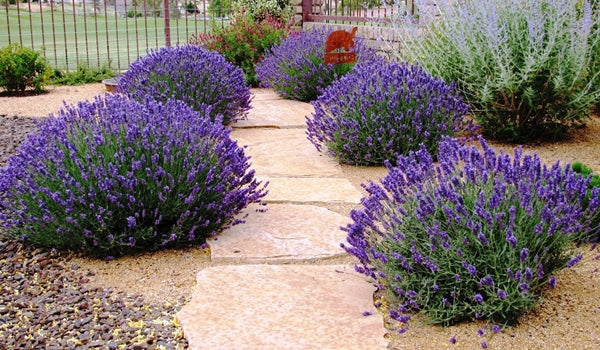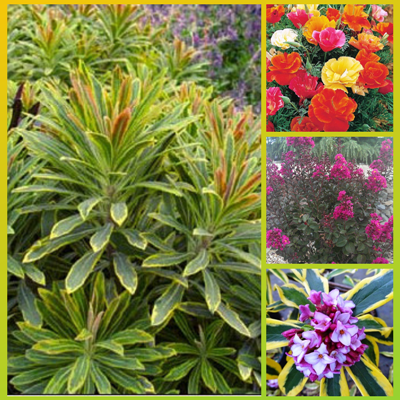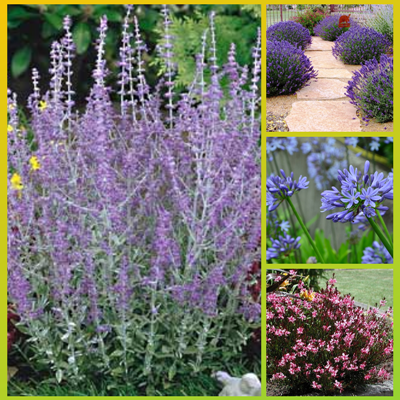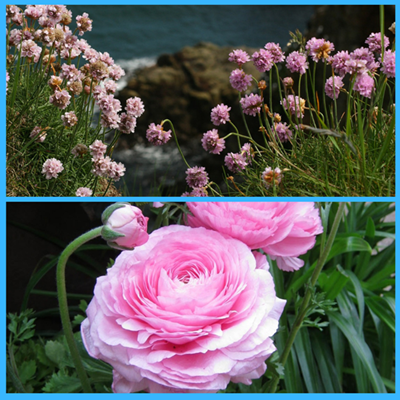by Ken
Lain, the mountain gardener
The
mountains of Arizona have so many sunny days with moderate temperatures that
people rarely need to wear more than light jackets. Mild winters and dry hot summers, both with
low humidity and irregular rainfalls, mimic the climate of the Mediterranean.

Many Mediterranean plants thrive locally, as both areas present the same challenges of growing flowers in regions that are beautiful yet harsh. Rocky soil, windswept mountain tops, and drought are a few of the conditions these 10 rugged Mediterranean flowers shrug off in local gardens.

Daphne, Euphorbia
California Poppy seems to take over entire Arizona mountainsides. How can blooms with such ethereal beauty be so tough? This welcome harbinger of spring adds its vivid orange hue to any garden with ample sunshine and light soil. Although the plant is an annual, it self-seeds and every year the bluish-green foliage makes newly emerging seedlings easy to recognize.
Crepe Myrtle, with its breathtaking flower colors, is a welcome sight during every garden’s late-summer lull. This is the perfect summer bloomer for gardens enhancing Prescott’s summer homes. With so many varieties available, it is popular to plant several of the different neon colors. Plant where you can enjoy a “close up” view of its beautiful multicolored bark and sinuous branches. Buy online or here at Watters.
Daphne is for the Mediterranean
garden that receives shade from oak or cypress trees; the shrub is a flattering
flowering companion to the trees. The highly fragrant shrub demands good
drainage, and likes protection from the mid-afternoon summer sun. Choose a
variety with variegated leaves, like ‘Maejima’, and you’ll have a beautiful
specimen plant, whether in or out of bloom.
Ascot Rainbow Euphorbia is commonly known as “spurge”. The many varieties of euphorbia have colorful
bracts rather than true flower petals. The electric shade of green foliage
provides an excellent complement to every other blossom color in the
garden. Local native “gopher plant” is a
direct descendant of Euphorbia, and absolutely deer proof.

Gaura, Russian Sage
Lavender bears a scent disliked by only very few people. How glorious it is to find a garden plant whose crushed leaves smell just as beautiful as the blossoms! If your garden is overwhelmed with shades of blue and purple, try one of the other-colored lavenders, like the white ‘Edelweiss’ or yellow ‘Chiffon.’ All lavenders are javelina and rabbit proof.
Midnight Blue Agapanthus, also known as
Lily-of-the-Nile, adds height, strong textural interest, and shades of royal
blue to the landscape. It multiplies
profusely so that you can take divisions for friends or other parts of the
garden. The plant adapts well to containers.
Passionate Rainbow Gaura offers a spring-to-fall profusion of rose-pink blossoms that
hover above variegated foliage that’s every bit as charming as the flowers.
With its exceptional tolerance to heat and drought, gaura is a lush addition to
rock gardens, borders, and containers.
Peek-A-Blue Russian Sage is a colorful, drought tolerant, easy-care choice for accent, border, or as a specimen in a sunny border. Airy lavender-blue spires crown well-mannered mounds of silvery textured foliage.

Ranunculus is a “beauty from ugly” phenom because from its strange,
claw-like tubers emerge some of the most densely ruffled blooms that resemble
peony flowers! It is so tough that it
will thrive through an early spring frost in a continual wave of flowers.
Sea Lavender, also known as beach heliotrope, gets its name because it
also grows well in a coastal garden beset by salt spray. The evergreen plants,
bearing bright purple flowers all summer, provide excellent erosion
control. Ideal companion plants are
black-eyed Susan, daylily, echeveria, sedum, and yarrow.
Until next week, I’ll be helping gardeners create Mediterranean garden styles
here at Watters Garden Center.
Ken Lain can be found throughout the week at Watters Garden Center, 1815 W. Iron Springs Rd in Prescott, or contacted through his web site at WattersGardenCenter.com or FB.com/WattersGardenCenter .


Ken (and Lisa),
Keep up the great work! Your articles are always very interesting and informative.
I subscribe to The Daily Courier. I cut out most of your articles so I can use them as a quick reference in the future. It’s not unusual for me to educate others on what may be their best choice.
Your valuable information helps me decide what plant or tree is probably the best in my situation.
Thank you for the outstanding job both of you do. We’re very fortunate to have you in our community.
Tom & Judy Rutherford
Tom,
Thanks for your support